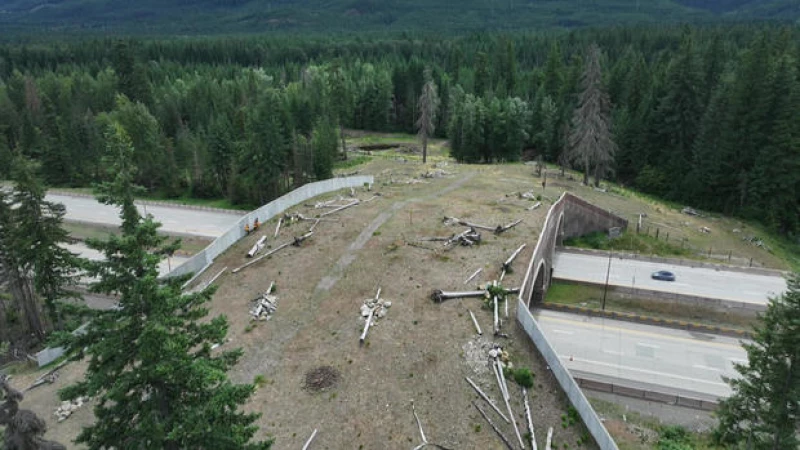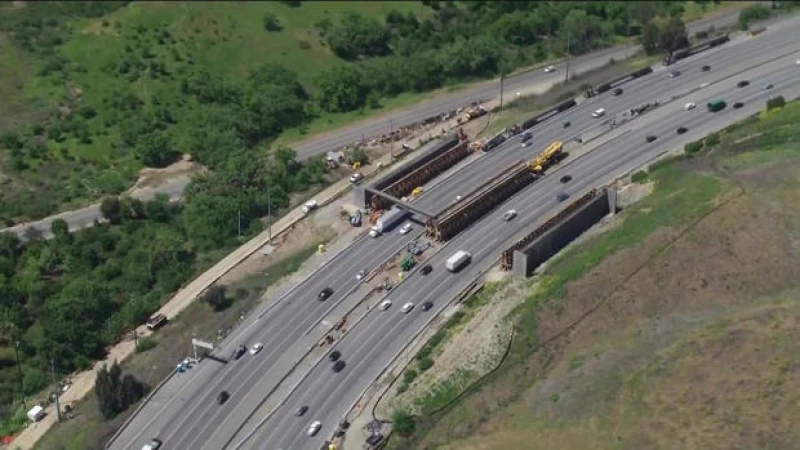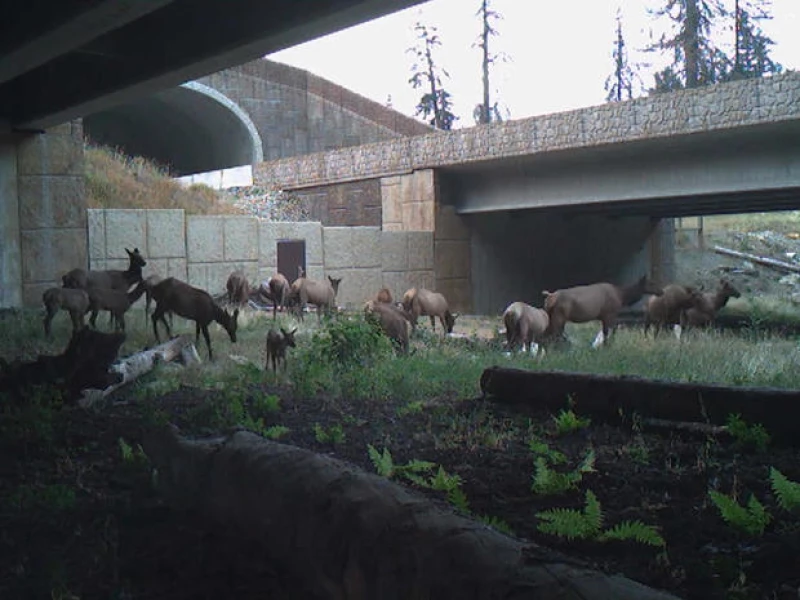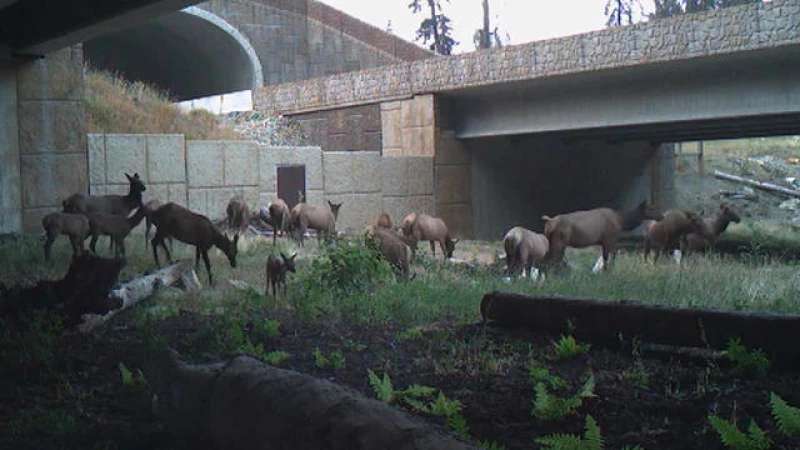Interstate 90 is the longest interstate highway in the United States. Spanning more than 3,000 miles, it connects Seattle in the west to Boston in the east. But it also serves as a massive concrete divide. For the animals who live to the north and south of the interstate, this road has absolutely wrecked their commute.
The U.S. Forest Service and the Washington State Department of Transportation have teamed up to develop a network of "critter crossings" in Washington – overpasses and underpasses designed to provide safe passage for wildlife.
The crossing project, with structures at areas identified where animals are likely to cross, spans 15 miles of I-90 near the Snoqualmie Pass in Washington, flanked by large chunks of what's primarily national forest land – habitat for all sorts of creatures great and small.
But if animals are protected on both sides of I-90, why does it matter if they're not connected? "Because you lose genetic variability," said Patty Garvey-Darda, a wildlife biologist with the Forest Service, "and gradually you start getting localized extinction, and populations get further and further apart, and smaller."
Across the nation, the majority of animals encounter a bustling highway and opt to turn back. A courageous few may attempt to cross, putting themselves at risk of being hit by passing vehicles. To mitigate this danger, wildlife crossings have been implemented. However, the construction of these crossings does not guarantee their use by animals. To guide wildlife towards these safe passages, miles of fencing line the road, directing animals to designated crossing points. Additionally, tall concrete walls are erected to shield animals from the glare of headlights and muffle the noise of passing traffic.
"Our goal is to replicate the natural habitat on both sides, including native plants, so that animals can seamlessly transition," explained Garvey-Darda.
The strategy proved effective. In 2022, surveillance cameras captured various animals, such as mule deer, elk, and coyotes, utilizing these crossings over 5,000 times.
Brian White of the Washington Department of Transportation cited the success of wildlife crossings in Banff, Alberta, Canada, as a model to emulate. The 38 undercrossings and six overcrossings in Banff National Park along the Trans-Canada Highway have led to an 80% reduction in wildlife collisions, serving as an inspiration for similar projects worldwide.
Across the United States, approximately 1,500 wildlife crossing structures are now in place across 43 states. In Wyoming, pronghorn antelope dash across Highway 191. In Florida, panthers and alligators safely pass beneath I-75. These crossings can be inconspicuous; motorists may unknowingly drive over passages used by moose in Montana or tunnels inhabited by tortoises in Utah.

The Wallis Annenberg Wildlife Crossing: A Lifeline for LA's Wildlife
As construction progresses on the impressive crossing near Los Angeles, anticipation grows for the completion of the Wallis Annenberg Wildlife Crossing in late 2025 or early 2026. Spanning over 200 feet across 10 lanes of the 101 Freeway, this corridor will become the largest wildlife crossing in the country, providing a safe passage for animals in the midst of a bustling urban landscape.
Beth Pratt, the regional executive director for the National Wildlife Federation in California, expressed her awe, stating, "I think that's a real miracle, that over one of the busiest freeways in the world you're gonna be driving under it, and mountain lion, fox, might be walking over. Or a fence lizard, or a ground squirrel may have a family on top. That's a really hopeful project. And we do owe it to P-22."
P-22, the iconic mountain lion that once roamed Griffith Park in L.A., symbolizes the importance of this crossing. Despite his ability to navigate two freeways in his youth, P-22's isolation led to a solitary existence until his passing in 2022.
With concerns about inbreeding and the potential extinction of local mountain lion populations, the $90 million wildlife crossing offers a lifeline by expanding the dating pool and ensuring genetic diversity. This initiative is not just about charismatic species like mountain lions but also benefits a wide range of wildlife that call this region home.

Professor Jason Irwin and his team of Central Washington University students are currently dedicated to studying the use of an underpass by various wildlife such as toads and salamanders beneath I-90. "It's truly rewarding to be involved in a project that values the importance of these small creatures," he expressed.
Moreover, aside from the wildlife, there is also a human aspect to consider. With around one million incidents of large wildlife collisions on American roads annually, approximately 200 human fatalities occur as a result.
Last year, a federal grant program worth $350 million was introduced by Transportation Secretary Pete Buttigieg to assist states in constructing wildlife crossings and enhancing safety.

Reports from White indicate a decline in collisions in areas where wildlife crossings have been implemented. "When you consider the accidents that were prevented, these crossing structures prove to be a worthwhile investment," he remarked.
Furthermore, reduced road closures lead to quicker commutes for all individuals.
Despite temporary delays and lane closures due to crossing construction in Los Angeles, Pratt noted that the public remains focused on the long-term advantages.
And fewer road closures mean faster commutes for everyone.
Even though the crossing construction in Los Angeles has meant occasional slowdowns and lane closures, Pratt said the public has been able to stay focused on the benefits down the road.
"Wildlife crossings are something, it doesn't matter if you're a Republican or a Democrat, or what political affiliation – people really support them," she said. "I think there's very few people who don't get upset when they see a dead animal on the side of the road. So, I think that this is something that in a time where we agree on very little, we pretty much agree on wildlife crossings."

For more info:
- U.S. Forest Service
- Washington State Department of Transportation
- National Wildlife Federation
- Wallis Annenberg Wildlife Crossing (Annenberg Foundation)
- SaveLACougars.org
Story produced by Michelle Kessel. Editor: Joseph Frandino.






